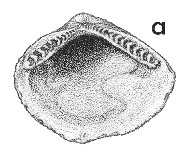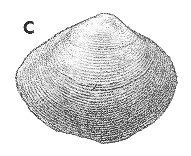
Revised descriptions of New Zealand Cenozoic Mollusca from Beu and Maxwell (1990)

 | Revised descriptions of New Zealand Cenozoic Mollusca from Beu and Maxwell (1990) | 
|
  (Pl. 27a): GS 13105, N02/f67, mouth of Waioha Stream, north shore Parengarenga Harbour, Northland, Otaian (GNS) |
  (Pl. 27c): GS 13105, N02/f67, mouth of Waioha Stream, north shore Parengarenga Harbour, Northland, Otaian (GNS) |
Beu & Maxwell (1990): Chapter 12; p. 243; pl. 27 a,c.
Classification: Neilonellidae
Description: Size moderate for genus (length 4.5-6.5 mm), ovate, strongly inflated, rather thick-shelled, anterior end convex, posterior end subangled. No lunule; escutcheon narrow, slightly concave. Commarginal sculpture of narrow, low, rounded ridges with interspaces of similar or somewhat greater width, absent from umbones. Radial sculpture of very weak striae only. Hinge relatively heavy, strongly arched, continuous and considerably thickened beneath beaks, anterior and posterior series of teeth meeting, i.e., not separated by a resilifer. Proximal 5 or 6 posterior teeth excavated dorsally to accommodate very short, external ligament. Adductor muscle scars flush or impressed, anterior one the larger; pallial sinus rounded, deep, extending about 0.33 length of shell. Internal margins smooth; interior highly polished.
Comparison: This new species is one of a group of small taxoodont bivalves that previously were referred to either Jupiteria Bellardi, 1875 (Nuculanidae) or to Austrotindaria Fleming, 1948 (Neilonellidae) but differ markedly from these genera in hinge and ligament characters (Maxwell 1988a, pp. 41-42). They are assigned to Pseudotindaria Sanders & Allen, 1977, which was proposed for deepwater bivalves resembling species of Tindaria Bellardi, 1875 in most shell characters but differing in having a well defined pallial sinus. Modern species of Pseudotindaria are from very deep water (abyssal) environments but records of fossil species from New Zealand are from much shallower (mostly bathyal) habitats (Maxwell 1988a, pp. 15, 42).
The Parengarenga species differs from Pseudotindaria kapua (Opoitian), P. kouhaiensis (Tongaporutuan or Kapitean) and P. nugax (Tongaporutuan) in having a relatively restricted smooth area on the umbones, and in its finer commarginal sculpture.
Distribution: Otaian, mouth of Waioha Stream, north shore of Parengarenga Harbour (common).
Cite this publication as: "A.G. Beu and J.I. Raine (2009). Revised
descriptions of New Zealand Cenozoic Mollusca from Beu and Maxwell (1990). GNS
Science miscellaneous series no. 27."
© GNS Science, 2009
ISBN
978-0-478-19705-1
ISSN 1177-2441
(Included with a PDF facsimile file
copy of New Zealand Geological Survey Paleontological Bulletin 58 in CD version
from: Publications Officer, GNS Science, P.O. Box 30368 Lower Hutt, New
Zealand)